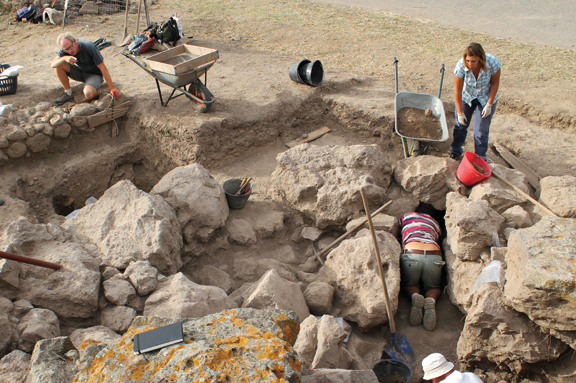Sardinia, the second largest island in the Mediterranean, is one of the
oldest continuously populated land masses in the world. Beginning in
about 1500 BCE, villages were centered on fortress-like structures
called nuraghi. Since summer 2013, archaeologist Peter Van Dommelen has
been excavating in Sardinia, looking for clues about prehistoric life
there. He particularly focuses on the classical period from 600 to 200
BCE, when the Phoenicians and Carthaginians arrived on the island as
conquerors. He paused recently to talk about his work.

BAM Why did you choose to study this later period in Sardinia’s history?
VAN DOMMELEN In the course
of the first millennium, an enormous change in lifestyle, culture, and
building style takes place. The original interpretation was that the
Sardinians were forced out of their traditional homes while outside
settlers created a colonial landscape.
BAM And that’s not true?
VAN DOMMELEN What we’re
finding now is more nuanced than that. People started interacting with
newcomers and adopting new ways of life, yet still kept some of their
older traditions. And we’re not finding that the indigenous settlements
were abandoned.
BAM What was life like during this time?
VAN DOMMELEN The
Phoenicians were traders who created a commercial network that reached
from modern Lebanon to Spain. They came to Sardinia for minerals and
built trading posts. In the later phase, when Carthage becomes the
dominant power, the emphasis shifts to agriculture. Agricultural
products were used to pay mercenaries. Sardinia became a major producer
of grain.
BAM You’ve also found evidence of a significant shift in ceramic pottery.
VAN DOMMELEN The Sardinian
ceramic tradition disappears by the sixth century, replaced by
Phoenician and Carthaginian pottery. In other words, these people have
gone modern. But there’s still a strong emphasis on cattle. The
utensils have changed, but what they’re eating has not.
BAM What’s it like to spend your summers off the coast of Italy?
VAN DOMMELEN What’s great
is that Sardinia is one of those rare places in the Mediterranean that
have been fairly well preserved because it is isolated and remote. The
landscape has not been destroyed as thoroughly as elsewhere. You won’t
find rows of fifty-story hotels.





